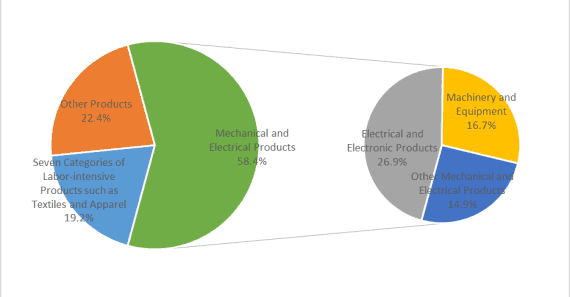7 characteristics of China’s foreign trade in 2019
In 2019, the total value of China’s import and export of goods trade was 31.54 trillion yuan, an increase of 3.4% over 2018. Among them, exports were 17.23 trillion yuan, an increase of 5% and imports were 14.31 trillion yuan, an increase of 1.6%; trade surplus was 2.92 trillion yuan, an increase of 25.4%. In the past year, the development of China’s foreign trade has shown an overall steady improvement. Specifically, the following is the 7 characteristics of China’s foreign trade in 2019:
I. Import and export scale climbs quarter by quarter–the 7 characteristics of China’s foreign trade in 2019
The import and export value in the first quarter of 2019 was 7.03 trillion yuan, 7.68 trillion yuan in the second quarter, 8.26 trillion yuan in the third and in the fourth quarter, it reached 8.59 trillion yuan. Among them, exports were 1.67 trillion yuan, an increase of 9% and imports were 1.34 trillion yuan, an increase of 17.7%. In December, the scale of foreign trade imports and exports all hit monthly, historical peaks.
II. Changes in the ranking of major trading partners–the 7 characteristics of China’s foreign trade in 2019
ASEAN became China’s second-largest trading partner. In 2019, the largest trading partner was and is still the EU, with imports and exports to the EU being 4.86 trillion yuan, an increase of 8%; the second-largest trading partner is ASEAN, with imports and exports to ASEAN at 4.43 trillion yuan, an increase of 14.1%. The third-largest trading partner is the United States, with imports and exports to the United States at 3.73 trillion yuan, a decrease of 10.7%. The fourth-largest trading partner is Japan, with import and export to Japan at 2.17 trillion yuan, an increase of 0.4%.
In addition, China’s imports and exports to countries along the “Belt and Road” were 9.27 trillion yuan, an increase of 10.8%, which was 7.4 percentage points higher than the overall growth rate.
III. Private enterprises become China’s largest foreign trade entity
In 2019, for the first time, private enterprises surpassed foreign-invested enterprises and became China’s largest foreign trade entity. The import and export of private enterprises were 13.48 trillion yuan, an increase of 11.4%, accounting for 42.7% of China’s total foreign trade value. This was an increase of 3.1 percentage points from 2018. Among them, exports were 8.9 trillion yuan, an increase of 13% and imports were 4.58 trillion yuan, an increase of 8.4%. Imports and exports of foreign-invested enterprises reached 12.57 trillion yuan, accounting for 39.9% of China’s total foreign trade value. The import and export of state-owned enterprises were 5.32 trillion yuan, accounting for 16.9%.
IV. Increase in the proportion of general trade imports and exports
In 2019, China’s trade structure was further optimized, and the proportion of general trade imports and exports increased. China’s general trade imports and exports totaled 18.61 trillion yuan, an increase of 5.6%, accounting for 59% of China’s total foreign trade value, which was an increase of 1.2 percentage points from 2018. Among them, exports were 9.95 trillion yuan, an increase of 7.8% and imports were 8.66 trillion yuan, an increase of 3.1%. The import and export of processing trade were 7.95 trillion yuan, down 5.1% and accounting for 25.2%.
V. Export products are mainly mechanical and electrical products and labor-intensive products
In 2019, China’s export products were mainly mechanical, electrical and labor-intensive products, and the proportion of mechanical and electrical products was close to 60%. Last year, China’s exports of mechanical and electrical products reached 10.06 trillion yuan, an increase of 4.4%, accounting for 58.4% of the total export value. Among them, exports of electrical and electronic products were 4.63 trillion yuan, an increase of 5.4%. Machinery and equipment were 2.87 trillion yuan, an increase of 1.4%. During the same period, the export of seven categories of labor-intensive products, such as textiles and apparel was 3.31 trillion yuan, an increase of 6.1%.
VI. Imports of bulk commodities such as iron ore, crude oil, natural gas, and soybeans increased
In 2019, China imported 1.069 billion tons of iron ore, an increase of 0.5%; imported crude oil of 506 million tons, an increase of 9.5%; imported natural gas of 96.56 million tons, an increase of 6.9%; and imported soybeans of 88.51 million tons, an increase of 0.5%. In addition, the import of meat products increased rapidly. The annual import of pork was 2.108 million tons, an increase of 75% and the import of beef was 1.659 million tons, an increase of 59.7%.
VII. New progress in high-quality development of China’s foreign trade in 2019
1. The structure of trade methods continued to be optimized.
In 2019, the import and export of general trade, which has a long industrial chain, higher added value, and better reflects the independent development capabilities of enterprises, increased by 5.6%, accounting for 59% of China’s foreign trade import and export, which increased by 1.2% compared to 2018.
2. New trade momentum has increased significantly.
Last year, new forms of foreign trade such as China’s cross-border e-commerce continued to flourish. Among them, imports and exports through the customs cross-border e-commerce management platform reached 186.21 billion yuan, an increase of 38.3%. The import and export of market procurement methods were 562.95 billion yuan, an increase of 19.7%. Together, the two contributed nearly 14% to overall foreign trade growth.
3. More diversified trade markets.
While Chinese enterprises continue to deeply cultivate traditional export markets, they continue to explore new markets with remarkable results. Just now, China talked about the “Belt and Road.” In 2019, China’s exports to the countries along the “Belt and Road” and Latin American countries increased. This was a very obvious result of opening up new markets.
4. International competitive advantage has improved significantly.
In 2019, the price index of China’s export commodities rose by 2.8%, the price index of imported commodities rose by 1.4%. The terms of trade index were 101.4, indicating that the same amount of goods exported by China can be exchanged for more goods. From this perspective, China’s competitive advantage has further improved.
According to the latest data from the WTO, from January to September 2019, the global market share of Chinese mechanical and electrical products and labor-intensive products increased by 0.2 and 0.9 percentage points, respectively. At the same time, exports of some high value-added products maintained a good growth trend. For example, China’s integrated circuit exports increased by 25.3% last year and semiconductor device exports increased by 26.3%. Solar cell exports increased by 47.5% and metal processing machine tools increased by nearly 15%. The effectiveness of the export brand building is also quite significant. Last year, the export of independent brand products was 2.9 trillion yuan, an increase of 12%, accounting for nearly 17% of the total export value, and this number has increased by 1.1 percentage points from 2018.
5. The import of consumer products for people’s livelihood has grown rapidly.
Last year, China successfully hosted the second expo. It lowered the import value-added tax rate, canceled some pharmaceutical import tariffs and actively expanded the import of consumer goods. It also enriched the supply of domestic goods and better met the people’s growing needs for a better life. In 2019, China’s imports of consumer goods increased by 19%, including imports of fruits, cosmetics, and aquatic products, which increased significantly, reaching 39.8%, 38.8%, and 37.6%. The import of electric manned vehicles increased by 1.2 times, and the import of human vaccines increased by nearly 90%. This shows that China’s huge consumer market has played a significant role in driving the growth of consumer goods imports.
Our Other Introductions
How to judge whether your suppliers are reliable?
What are the 7 Regions of China?
The Top 10 China Sourcing Websites





 verifyfull.com
verifyfull.com verifyfull.com
verifyfull.com
